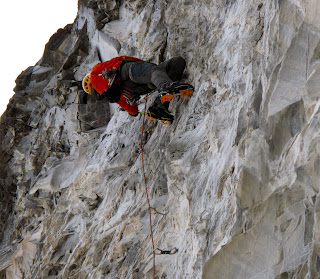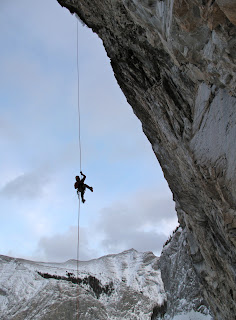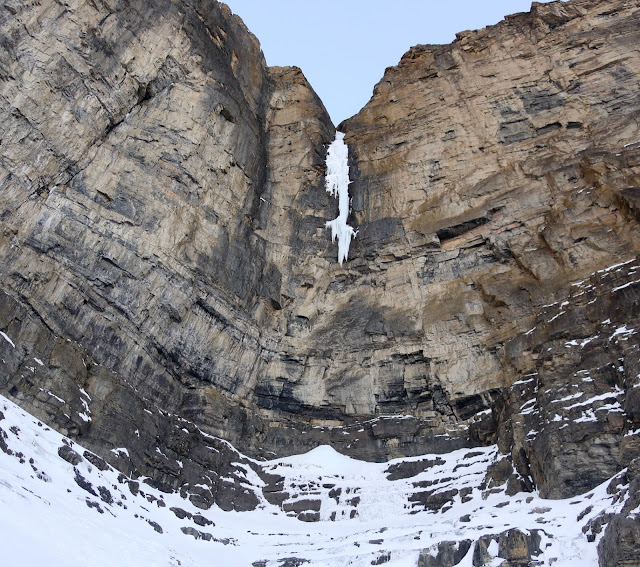Industrial climbing
There is something ugly and industrial about drytooling. To begin with there is the fact that one does not experience the rock directly, with one's hands and feet, but through metal tools. The scraping of steel on stone is something one might expect to hear on a factory floor, not in a quiet wintry valley. Even the movement is somehow angular and mechanical, not fluid and organic like in rock climbing. And yet there is something compelling about drytooling - perhaps as compelling as Chouinard's runaway locomotive.
The Jimmy Skid Rig (TJSR), a route that enjoyed some notoriety on Rockies' Internet bulletin boards three years back, is a nice example of the good, bad and ugly sides of drytooling. Last month I finally got past the route's initial hype and subsequent obscurity and actually experienced it for myself. It did not happen by design. Jon Walsh and I left the city at an uncivilized hour to wrap up a project on the Headwall. Two hours later we pulled into the Stanley parking lot in the midst of a light but steady snowfall. Not feeling sufficiently Scottish to spend all day hoovering snow from holds, we turned around and drove back east. After much brainstorming, Jon suggested we go have a look at TJSR. I was not that keen, but lacking a counter proposal I said something decisive like "I suppose we could..." and we were committed.
The route description (which Jon pulled off of the Internet while I drove) made the approach sound rather epic: a slot-canyon adventure course taking up to five hours. I resigned myself to taking my tools for a walk, and thus was pleasantly surprised when after two and a half hours of hiking through open forest we were dropping our packs at the base of the route. The line was an impressive one to be sure. Some discontinuous smears led up to a horizontal break, at which point things reared up steeply, with an anemic dagger barely visible over the lip of the roof far above. Less impressive was the industrial debris scattered everywhere: a pair of rusty crampons, a frozen water bottle, a couple of weathered ropes swinging forlornly in the breeze... Somehow it was appropriate that the only sound in the whole empty valley was the distant drone of the cement plant on Grotto Mountain.
The actual climbing was surprisingly good. Even with a sprinkling of bolts the first pitch had a distinctly traditional feel, with thin ice and loose rock. The gymnastics started soon thereafter. After spending five minutes fruitlessly searching for the next drytool placement I swallowed my on-sighting pride and hung on the rope. It took me another few minutes to find the drilled pocket that was the key to the sequence. Aha! So that was the name of the game! My newfound knowledge of the rules came in handy on the crux third pitch. Having blown my on-sight already, I hangdogged my way up to an intermediate anchor, patiently mapping the hard-to-see manufactured holds. With daylight fading we bailed, but not before stripping the old ropes and leaving them coiled at the base.
Having climbed all over the world, from Baffin to the Bugs to Patagonia, Jon has a keen sense of the aesthetics of a route. Between the loose rock and the extensive chipping, he was not psyched to go back. But unfortunately I seem unable to let go of a route I have started it, however shitty it might be. Not that TJSR is that shitty: being a Rockies' rat I have climbed far worse. OK, so that might not be saying much. I suppose I simply found the route enjoyable, warts, choss, drilled pockets and all.
Next weekend I asked Jerome Yerly if we fancied having a go at TJSR. Being Swiss and polite to a fault, he said yes. The walk in was as pleasant as I remembered it, and soon I was racking up at the base with an untold number of quickdraws, six screws and one gold Camalot. To save time I skipped a couple of belays and fought rope drag to the start of the steep stuff. The second pitch required some pulling down, but knowing about the key drilled hole made all the difference, and in no time I was ensconced at the base of the business.
I remembered enough of the sequences to make it to the previous week's highpoint without hanging. An elbow hooked behind a cammed tool let me catch my breath before continuing into the unknown. I was not optimistic about my chances: on-sighting steep limestone with its complicated textures is tricky enough without having to look for chipped holds in weird places. But I must have been getting better at reading the mind of the creator, and methodically found one hole after another. For a couple of panicked seconds I thought I might blow it at the very end, as I desperately swung at the lip of the broken dagger, but thankfully the tools bit into the desiccated ice, and at long last I got my feet under me. In a way the ice to the top was a formality, but of course it was what gave the whole route its raison d'être.
So what is the moral of my story? That manufactured routes are fun and we need more of them? I certainly had a blast on TJSR. However, if someone chipped a line on the Terminator Wall or the Stanley Headwall instead of an obscure wall on Pigeon Mountain, I expect I would feel differently about it. Even on Pigeon I was ambivalent about the style in which the route was established. Yes, it was fun not to slide off of holds - once you found them - and to climb hard (whatever that might mean) high above the valley floor. But it also bothered me to have the climbing experience reduced to executing a sequence of contrived moves. Then again, what is chipping? If I am fine with aggressively cleaning holds using an ice tool, then what is wrong with using another tool - such as a drill - for the same purpose?
In the end, what am I saying? Am I suggesting the route should be chopped? Emulated? One thing is clear: TJSR does not infringe on previously established routes, in fact there is not another route for kilometres around. I believe it should be allowed to remain and stand on its own merits. Check it out for yourself, and decide if it is a step forward or back.
The Jimmy Skid Rig (TJSR), a route that enjoyed some notoriety on Rockies' Internet bulletin boards three years back, is a nice example of the good, bad and ugly sides of drytooling. Last month I finally got past the route's initial hype and subsequent obscurity and actually experienced it for myself. It did not happen by design. Jon Walsh and I left the city at an uncivilized hour to wrap up a project on the Headwall. Two hours later we pulled into the Stanley parking lot in the midst of a light but steady snowfall. Not feeling sufficiently Scottish to spend all day hoovering snow from holds, we turned around and drove back east. After much brainstorming, Jon suggested we go have a look at TJSR. I was not that keen, but lacking a counter proposal I said something decisive like "I suppose we could..." and we were committed.
The route description (which Jon pulled off of the Internet while I drove) made the approach sound rather epic: a slot-canyon adventure course taking up to five hours. I resigned myself to taking my tools for a walk, and thus was pleasantly surprised when after two and a half hours of hiking through open forest we were dropping our packs at the base of the route. The line was an impressive one to be sure. Some discontinuous smears led up to a horizontal break, at which point things reared up steeply, with an anemic dagger barely visible over the lip of the roof far above. Less impressive was the industrial debris scattered everywhere: a pair of rusty crampons, a frozen water bottle, a couple of weathered ropes swinging forlornly in the breeze... Somehow it was appropriate that the only sound in the whole empty valley was the distant drone of the cement plant on Grotto Mountain.
The sun comes up on Grotto Mountain, cement plant and all.
TJSR, a "huge M12"? It depends on who you ask.
The actual climbing was surprisingly good. Even with a sprinkling of bolts the first pitch had a distinctly traditional feel, with thin ice and loose rock. The gymnastics started soon thereafter. After spending five minutes fruitlessly searching for the next drytool placement I swallowed my on-sighting pride and hung on the rope. It took me another few minutes to find the drilled pocket that was the key to the sequence. Aha! So that was the name of the game! My newfound knowledge of the rules came in handy on the crux third pitch. Having blown my on-sight already, I hangdogged my way up to an intermediate anchor, patiently mapping the hard-to-see manufactured holds. With daylight fading we bailed, but not before stripping the old ropes and leaving them coiled at the base.
Jon Walsh connects the dots on the opening pitch...
... and overhangs the base of the route on the second one.
Having climbed all over the world, from Baffin to the Bugs to Patagonia, Jon has a keen sense of the aesthetics of a route. Between the loose rock and the extensive chipping, he was not psyched to go back. But unfortunately I seem unable to let go of a route I have started it, however shitty it might be. Not that TJSR is that shitty: being a Rockies' rat I have climbed far worse. OK, so that might not be saying much. I suppose I simply found the route enjoyable, warts, choss, drilled pockets and all.
Next weekend I asked Jerome Yerly if we fancied having a go at TJSR. Being Swiss and polite to a fault, he said yes. The walk in was as pleasant as I remembered it, and soon I was racking up at the base with an untold number of quickdraws, six screws and one gold Camalot. To save time I skipped a couple of belays and fought rope drag to the start of the steep stuff. The second pitch required some pulling down, but knowing about the key drilled hole made all the difference, and in no time I was ensconced at the base of the business.
Jerome Yerly, always having fun.
I remembered enough of the sequences to make it to the previous week's highpoint without hanging. An elbow hooked behind a cammed tool let me catch my breath before continuing into the unknown. I was not optimistic about my chances: on-sighting steep limestone with its complicated textures is tricky enough without having to look for chipped holds in weird places. But I must have been getting better at reading the mind of the creator, and methodically found one hole after another. For a couple of panicked seconds I thought I might blow it at the very end, as I desperately swung at the lip of the broken dagger, but thankfully the tools bit into the desiccated ice, and at long last I got my feet under me. In a way the ice to the top was a formality, but of course it was what gave the whole route its raison d'être.
The crux third pitch goes on and on, rather like this sentence...
... with good tool placements but curiously poor feet...
... a combination than lets one get viciously pumped.
So what is the moral of my story? That manufactured routes are fun and we need more of them? I certainly had a blast on TJSR. However, if someone chipped a line on the Terminator Wall or the Stanley Headwall instead of an obscure wall on Pigeon Mountain, I expect I would feel differently about it. Even on Pigeon I was ambivalent about the style in which the route was established. Yes, it was fun not to slide off of holds - once you found them - and to climb hard (whatever that might mean) high above the valley floor. But it also bothered me to have the climbing experience reduced to executing a sequence of contrived moves. Then again, what is chipping? If I am fine with aggressively cleaning holds using an ice tool, then what is wrong with using another tool - such as a drill - for the same purpose?
In the end, what am I saying? Am I suggesting the route should be chopped? Emulated? One thing is clear: TJSR does not infringe on previously established routes, in fact there is not another route for kilometres around. I believe it should be allowed to remain and stand on its own merits. Check it out for yourself, and decide if it is a step forward or back.












Awesome.
ReplyDeleteIt is truely a Jimmy Skid Rig.
From our first day on it in 2007 (I think). It is a wild place, the scene of some eastern posers, a world class ice climber and some goat skulls. You are likely the first to tread where we had tread. We had no place there but since no one else was wondering there, we did. We could not finish it due to our inability to crush at that level. WG showed up and sent, manufactured or not, it is a legit place to hang out. I hope more walkers tread the line. I will collect the trash at the base, it has no function in the hills anymore.
Cheers.
Brandon.
Brandon,
ReplyDeleteI can fully understand why you were psyched about the line, it's an impressive one for sure. The rock is a bit of a mixed bag but hey, it's the Rockies! Good on you and Will M. for putting in all that effort to build the rig. I wish there were more people out there putting up bigger routes like that for everyone to play on. If nothing else, it's a better outlet for pent up energy than retrobolting old traditional lines.
Anyway, I'm glad to hear you'll collect the trash, like you said, it has no place in the hills. And yeah, people should get on the route, it has a lot going for it: a reasonable approach, minimal avy hazard, and hard climbing in a cool setting. The drilled holds take away from the quality, and I hope that kind of thing does not become standard practice. But, just as we can have fun pulling down on Shep's Diner while not wanting to see that kind of blatant chipping become the norm, so we can take our guilty pleasure on TJSR.
Take care,
Raphael
Stoked you got up there Raph! I will definitely agree that the Jimmy Skid Rig is what it is.
ReplyDelete"Even with a sprinkling of bolts the first pitch had a distinctly traditional feel, with thin ice and loose rock." - Reading this brought back some good memories as I did that pitch while rope soloing, placing bolts with a hand drill, and smoking hand rolled cigarettes to pass the time. Good stuff!
Will Meinen